文化(复习资料)
- 格式:doc
- 大小:138.00 KB
- 文档页数:19
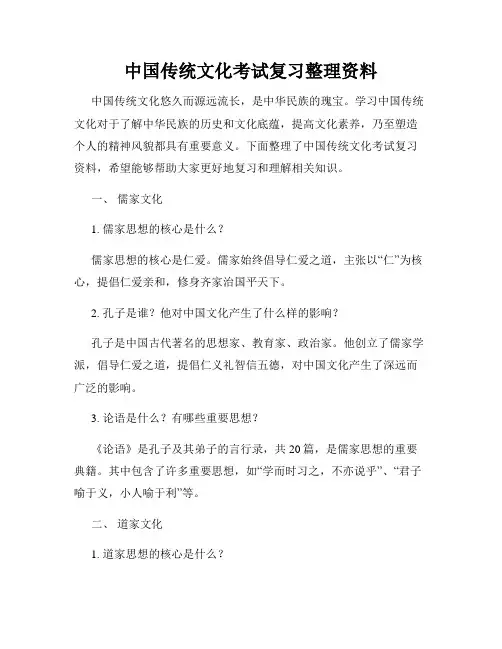
中国传统文化考试复习整理资料中国传统文化悠久而源远流长,是中华民族的瑰宝。
学习中国传统文化对于了解中华民族的历史和文化底蕴,提高文化素养,乃至塑造个人的精神风貌都具有重要意义。
下面整理了中国传统文化考试复习资料,希望能够帮助大家更好地复习和理解相关知识。
一、儒家文化1. 儒家思想的核心是什么?儒家思想的核心是仁爱。
儒家始终倡导仁爱之道,主张以“仁”为核心,提倡仁爱亲和,修身齐家治国平天下。
2. 孔子是谁?他对中国文化产生了什么样的影响?孔子是中国古代著名的思想家、教育家、政治家。
他创立了儒家学派,倡导仁爱之道,提倡仁义礼智信五德,对中国文化产生了深远而广泛的影响。
3. 论语是什么?有哪些重要思想?《论语》是孔子及其弟子的言行录,共20篇,是儒家思想的重要典籍。
其中包含了许多重要思想,如“学而时习之,不亦说乎”、“君子喻于义,小人喻于利”等。
二、道家文化1. 道家思想的核心是什么?道家思想的核心是“道”。
道家强调顺应自然、不刻意施为,重视修身养性、养生保健,追求身心合一的境界和解脱。
2. 老子是谁?他对中国文化产生了什么样的影响?老子是中国古代著名哲学家,被认为是道家学派的创始人,《道德经》是其代表作。
老子强调“无为而治”,对中国文化产生了深远的影响。
3. 道德经是什么?有哪些重要思想?《道德经》是道家的重要经典之一,共有81章。
其中包含了许多重要思想,如“道可道,非常道,名可名,非常名”、“知足不辱”等。
三、佛家文化1. 佛教的创始人是谁?佛教的核心思想是什么?佛教的创始人是释迦牟尼佛,佛教的核心思想是解脱生死轮回,超脱尘世,追求涅槃。
2. 《金刚经》是佛教的重要经典之一,有何特点?《金刚经》是佛教的重要经典之一,主张“一切有为法,如梦幻泡影,如露亦如电,应作如是观”。
3. 佛教传入中国后,融入了哪些本土文化元素?佛教传入中国后,融入了道教、儒家等本土文化元素,形成了独具中国特色的佛教文化。
以上便是中国传统文化考试复习整理资料,希望对大家的学习有所帮助。
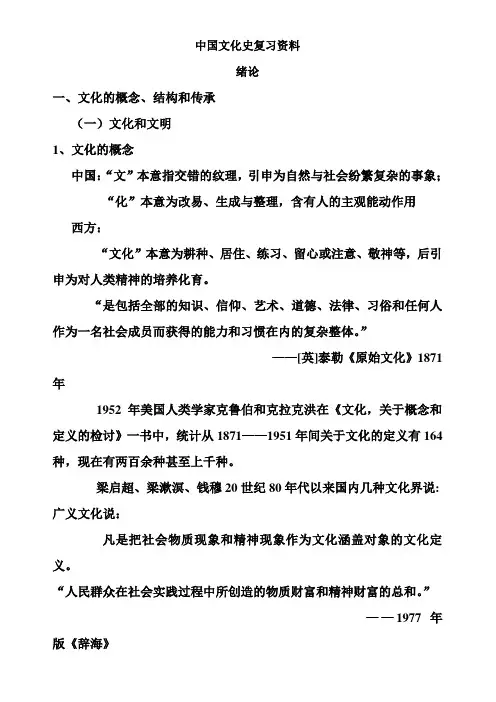
中国文化史复习资料绪论一、文化的概念、结构和传承(一)文化和文明1、文化的概念中国:“文”本意指交错的纹理,引申为自然与社会纷繁复杂的事象;“化”本意为改易、生成与整理,含有人的主观能动作用西方:“文化”本意为耕种、居住、练习、留心或注意、敬神等,后引申为对人类精神的培养化育。
“是包括全部的知识、信仰、艺术、道德、法律、习俗和任何人作为一名社会成员而获得的能力和习惯在内的复杂整体。
”——[英]泰勒《原始文化》1871年1952年美国人类学家克鲁伯和克拉克洪在《文化,关于概念和定义的检讨》一书中,统计从1871——1951年间关于文化的定义有164种,现在有两百余种甚至上千种。
梁启超、梁漱溟、钱穆20世纪80年代以来国内几种文化界说: 广义文化说:凡是把社会物质现象和精神现象作为文化涵盖对象的文化定义。
“人民群众在社会实践过程中所创造的物质财富和精神财富的总和。
”——1977年版《辞海》“人类社会历史实践中所创造的物质财富和精神财富的总和。
”——1982年《现代汉语词典》把文化涵盖对象限定在精神现象和精神活动方面的文化定义。
“特指精神财富,如文学、艺术、教育、科学等。
”“专指社会意识形态以及与之相适应的制度和组织机构。
”归结为生活方式、民族心理结构、思维方式、知识系统等等文化多义兼容说”广义地说,指人类的活动方式几创造的物质、精神成果的总和。
中义而言,它可以理解为意识形态的一部分,也就是人类创造的精神产品,如文学、艺术、哲学、科学、法律、道德、伦理、习俗风尚等观念性的东西。
狭义指人类的一般知识及运用文字的能力、水平等。
“2、文化与文明文化、文明同义说施宜圆《中国文化辞典》1987年;袁方《社会学百科辞典》1991 认为文明与文化没有多大差别文明大于文化说钱学森、罗大冈”文明包括文化,而文化不能替代文明”最早见“见龙在田,天下文明”—《易·乾·文言》指社会生活光彩绚烂,其义包括文化文化大于文明说汪澍白“濬哲文明”——孔颖达《尚书·舜典》疏解:“经天纬地曰文,照临四方曰明。
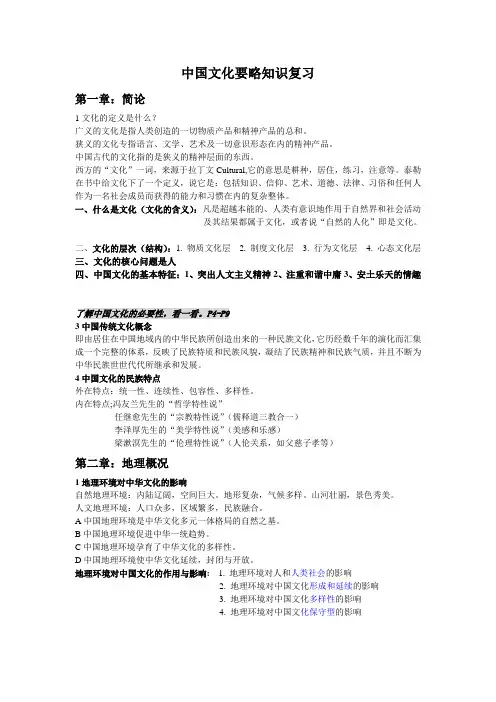
中国文化要略知识复习第一章:简论1文化的定义是什么?广义的文化是指人类创造的一切物质产品和精神产品的总和。
狭义的文化专指语言、文学、艺术及一切意识形态在内的精神产品。
中国古代的文化指的是狭义的精神层面的东西。
西方的“文化”一词,来源于拉丁文Cultural,它的意思是耕种,居住,练习,注意等。
泰勒在书中给文化下了一个定义,说它是:包括知识、信仰、艺术、道德、法律、习俗和任何人作为一名社会成员而获得的能力和习惯在内的复杂整体。
一、什么是文化(文化的含义):凡是超越本能的、人类有意识地作用于自然界和社会活动及其结果都属于文化,或者说“自然的人化”即是文化。
二、文化的层次(结构):1. 物质文化层 2. 制度文化层 3. 行为文化层 4. 心态文化层三、文化的核心问题是人四、中国文化的基本特征:1、突出人文主义精神2、注重和谐中庸3、安土乐天的情趣了解中国文化的必要性,看一看。
P4-P93中国传统文化概念即由居住在中国地域内的中华民族所创造出来的一种民族文化,它历经数千年的演化而汇集成一个完整的体系,反映了民族特质和民族风貌,凝结了民族精神和民族气质,并且不断为中华民族世世代代所继承和发展。
4中国文化的民族特点外在特点:统一性、连续性、包容性、多样性。
内在特点;冯友兰先生的“哲学特性说”任继愈先生的“宗教特性说”(儒释道三教合一)李泽厚先生的“美学特性说”(美感和乐感)梁漱溟先生的“伦理特性说”(人伦关系,如父慈子孝等)第二章:地理概况1地理环境对中华文化的影响自然地理环境:内陆辽阔,空间巨大。
地形复杂,气候多样。
山河壮丽,景色秀美。
人文地理环境:人口众多,区域繁多,民族融合。
A中国地理环境是中华文化多元一体格局的自然之基。
B中国地理环境促进中华一统趋势。
C中国地理环境孕育了中华文化的多样性。
D中国地理环境使中华文化延续,封闭与开放。
地理环境对中国文化的作用与影响: 1. 地理环境对人和人类社会的影响2. 地理环境对中国文化形成和延续的影响3. 地理环境对中国文化多样性的影响4. 地理环境对中国文化保守型的影响2自然地理基本要点四大高原:青藏高原,内蒙古高原,黄土高原,云贵高原四大盆地:塔里木盆地,准格尔盆地,柴达木盆地,四川盆地四大平原:东北平原,华北平原,长江中下游平原,珠江三角洲平原3行政区划是国家行政管理的区域性组织系统。
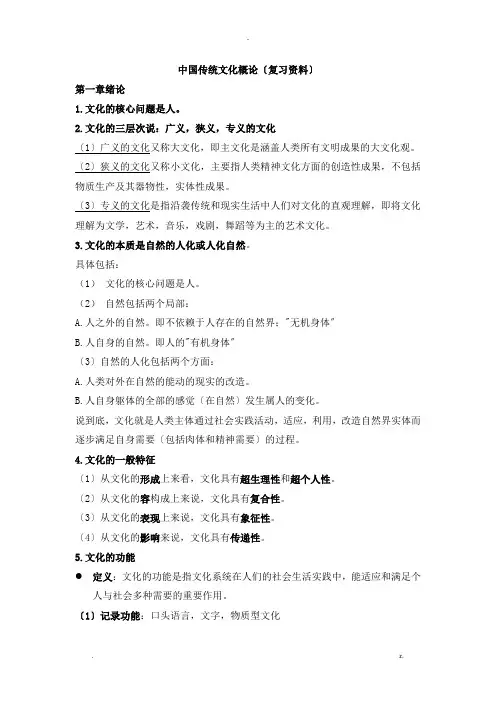
中国传统文化概论〔复习资料〕第一章绪论1.文化的核心问题是人。
2.文化的三层次说:广义,狭义,专义的文化〔1〕广义的文化又称大文化,即主文化是涵盖人类所有文明成果的大文化观。
〔2〕狭义的文化又称小文化,主要指人类精神文化方面的创造性成果,不包括物质生产及其器物性,实体性成果。
〔3〕专义的文化是指沿袭传统和现实生活中人们对文化的直观理解,即将文化理解为文学,艺术,音乐,戏剧,舞蹈等为主的艺术文化。
3.文化的本质是自然的人化或人化自然。
具体包括:(1)文化的核心问题是人。
(2)自然包括两个局部:A.人之外的自然。
即不依赖于人存在的自然界;"无机身体〞B.人自身的自然。
即人的"有机身体〞〔3〕自然的人化包括两个方面:A.人类对外在自然的能动的现实的改造。
B.人自身躯体的全部的感觉〔在自然〕发生属人的变化。
说到底,文化就是人类主体通过社会实践活动,适应,利用,改造自然界实体而逐步满足自身需要〔包括肉体和精神需要〕的过程。
4.文化的一般特征〔1〕从文化的形成上来看,文化具有超生理性和超个人性。
〔2〕从文化的容构成上来说,文化具有复合性。
〔3〕从文化的表现上来说,文化具有象征性。
〔4〕从文化的影响来说,文化具有传递性。
5.文化的功能定义:文化的功能是指文化系统在人们的社会生活实践中,能适应和满足个人与社会多种需要的重要作用。
〔1〕记录功能:口头语言,文字,物质型文化〔2〕认知功能:人类总是不断地通过文化来认识自然,社会,自身,世界。
〔3〕传播功能:言语和文字,实物〔4〕教化功能:文化不仅自觉地教化人,而且更多时候是潜移默化的教化人,使之社会化。
〔5〕凝聚功能:在民族群体中表现的尤为明显。
中华民族文化的凝聚功能主要表现为爱国主义;文化层次不同,文化凝聚围,程度,层次也不同。
〔6〕调控功能:主要依靠精神型文化和制度行为文化来实现。
6.文化形态学角度将广义文化分为四个层次:〔1〕物态文化;是指人的物质生产活动方式和产品的总和〔2〕制度文化;是人类在社会实践中建立起来的各种社会规的总和。
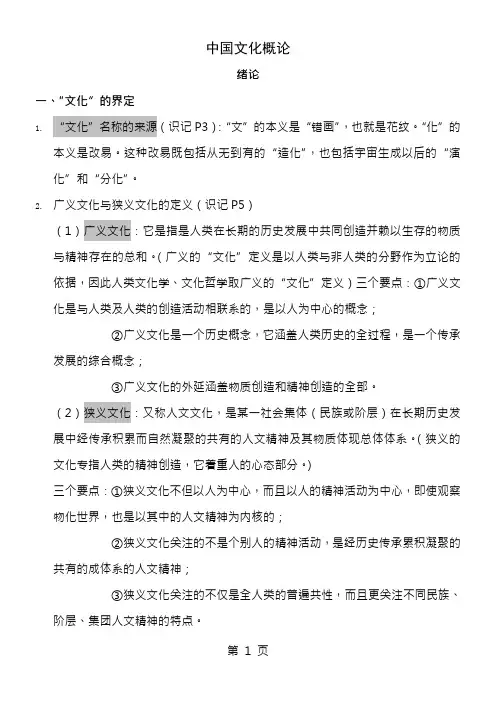
中国文化概论绪论一、“文化”的界定1.“文化”名称的来源(识记P3):“文”的本义是“错画”,也就是花纹。
“化”的本义是改易。
这种改易既包括从无到有的“造化”,也包括宇宙生成以后的“演化”和“分化”。
2.广义文化与狭义文化的定义(识记P5)(1)广义文化:它是指是人类在长期的历史发展中共同创造并赖以生存的物质与精神存在的总和。
(广义的“文化”定义是以人类与非人类的分野作为立论的依据,因此人类文化学、文化哲学取广义的“文化”定义)三个要点:①广义文化是与人类及人类的创造活动相联系的,是以人为中心的概念;②广义文化是一个历史概念,它涵盖人类历史的全过程,是一个传承发展的综合概念;③广义文化的外延涵盖物质创造和精神创造的全部。
(2)狭义文化:又称人文文化,是某一社会集体(民族或阶层)在长期历史发展中经传承积累而自然凝聚的共有的人文精神及其物质体现总体体系。
(狭义的文化专指人类的精神创造,它着重人的心态部分。
)三个要点:①狭义文化不但以人为中心,而且以人的精神活动为中心,即使观察物化世界,也是以其中的人文精神为内核的;②狭义文化关注的不是个别人的精神活动,是经历史传承累积凝聚的共有的成体系的人文精神;③狭义文化关注的不仅是全人类的普遍共性,而且更关注不同民族、阶层、集团人文精神的特点。
3.各种与文化相关概念的正名(识记P6)(1)文化产品:广义的文化产品指人类创造的一切提供给社会的可见产品,既包括物质产品,也包括精神产品;狭义的文化产品专指精神产品,纯粹实用的生产工具、生活器具、能源资材等,一般不称为文化产品。
(2)文化内涵:它是把一些不属于狭义文化的事物中所具有的人文特性凸现出来,称为事物的文化内涵。
(3)文化现象:指的是人类文化发展过程中呈现出的某种外部状态和联系。
(4)文化事象:在某一历史时期、某一国家(民族或地域)文化发展中带有典型和标志作用的事情反复出现时,这种含有规律性的现象称为文化事象。
(文化事象的类型性、文化事象的变异性)(5)文化观念:一个时期某一阶层或某一行业的人群对文化问题所持的态度和看法,或在某一文化事象里所表现的意识形态,诸如价值观、审美观等等,称作文化观念。
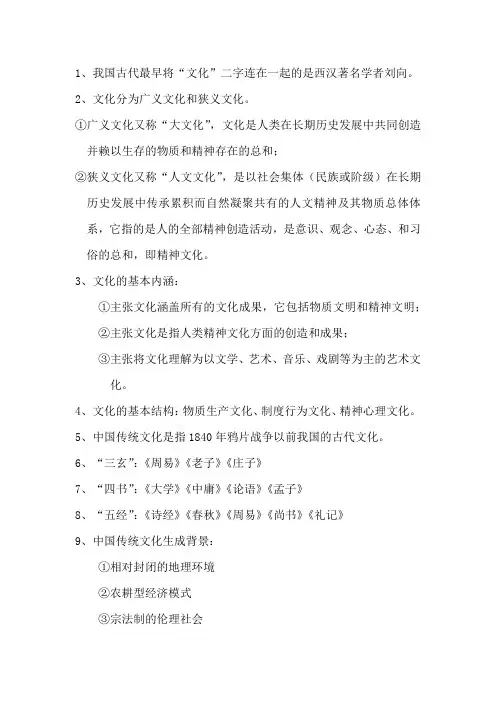
1、我国古代最早将“文化”二字连在一起的是西汉著名学者刘向。
2、文化分为广义文化和狭义文化。
①广义文化又称“大文化”,文化是人类在长期历史发展中共同创造并赖以生存的物质和精神存在的总和;②狭义文化又称“人文文化”,是以社会集体(民族或阶级)在长期历史发展中传承累积而自然凝聚共有的人文精神及其物质总体体系,它指的是人的全部精神创造活动,是意识、观念、心态、和习俗的总和,即精神文化。
3、文化的基本内涵:①主张文化涵盖所有的文化成果,它包括物质文明和精神文明;②主张文化是指人类精神文化方面的创造和成果;③主张将文化理解为以文学、艺术、音乐、戏剧等为主的艺术文化。
4、文化的基本结构:物质生产文化、制度行为文化、精神心理文化。
5、中国传统文化是指1840年鸦片战争以前我国的古代文化。
6、“三玄”:《周易》《老子》《庄子》7、“四书”:《大学》《中庸》《论语》《孟子》8、“五经”:《诗经》《春秋》《周易》《尚书》《礼记》9、中国传统文化生成背景:①相对封闭的地理环境②农耕型经济模式③宗法制的伦理社会10、四大文明古国:中国、古埃及、古印度、古巴比伦11、中国传统文化的特征与基本精神:①赤子之情:饱蘸深情的爱国精神②关注人生:仁者爱人的人本精神③道法自然:天人合一的和合精神④生生不息:有容乃大的兼容精神⑤担当大义:厚德载物的伦理精神⑥关注现实:经世致用的务实精神12、如何创新中国传统文化①弘扬民族文化,培育民族精神②发掘文化内涵,熔铸时代精神③植根于民族土壤,不断走向世界④善于鉴别审视,不断创新传统13、五行:①相生:水——木——火——土——金②相克:金——木——土——水——火14、萌芽:五行说、八卦说、阴阳说15、中国古代哲学是中国传统文化的精髓和灵魂16、中国古代哲学的主要特征:①重人生;②重践履;③重道德;④重和谐;⑤重直觉17、儒家创始人:孔子(名丘)。
“仁”是孔子思想体系的核心。
他主张“仁者爱人”“己所不欲,勿施于人”,以爱人之心调节与和谐社会人际关系。
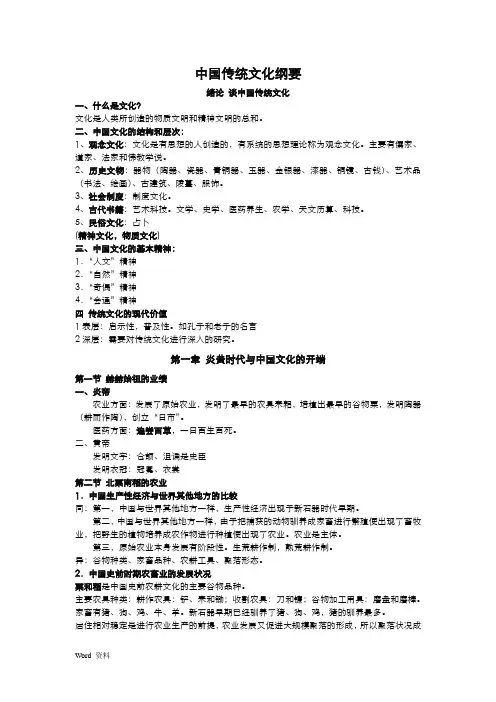
中国传统文化纲要绪论谈中国传统文化一、什么是文化?文化是人类所创造的物质文明和精神文明的总和。
二、中国文化的结构和层次:1、观念文化:文化是有思想的人创造的,有系统的思想理论称为观念文化。
主要有儒家、道家、法家和佛教学说。
2、历史文物:器物(陶器、瓷器、青铜器、玉器、金银器、漆器、铜镜、古钱)、艺术品(书法、绘画)、古建筑、陵墓、服饰。
3、社会制度:制度文化。
4、古代书籍:艺术科技。
文学、史学、医药养生、农学、天文历算、科技。
5、民俗文化:占卜(精神文化,物质文化)三、中国文化的基本精神:1.“人文”精神2.“自然”精神3.“奇偶”精神4.“会通”精神四传统文化的现代价值1表层:启示性,普及性。
如孔子和老子的名言2深层:需要对传统文化进行深入的研究。
第一章炎黄时代与中国文化的开端第一节赫赫始祖的业绩一、炎帝农业方面:发展了原始农业,发明了最早的农具耒耜,培植出最早的谷物粟,发明陶器(耕而作陶),创立“日市”。
医药方面:遍尝百草,一日百生百死。
二、黄帝发明文字:仓颉、沮诵是史臣发明衣冠:冠冕、衣裳第二节北粟南稻的农业1.中国生产性经济与世界其他地方的比较同:第一,中国与世界其他地方一样,生产性经济出现于新石器时代早期。
第二,中国与世界其他地方一样,由于把捕获的动物驯养成家畜进行繁殖便出现了畜牧业,把野生的植物培养成农作物进行种植便出现了农业。
农业是主体。
第三,原始农业本身发展有阶段性。
生荒耕作制,熟荒耕作制。
异:谷物种类、家畜品种、农耕工具、聚落形态。
2.中国史前时期农畜业的发展状况粟和稻是中国史前农耕文化的主要谷物品种。
主要农具种类:耕作农具:铲、耒和锄;收割农具:刀和镰;谷物加工用具:磨盘和磨棒。
家畜有猪、狗、鸡、牛、羊。
新石器早期已经驯养了猪、狗、鸡,猪的驯养最多。
居住相对稳定是进行农业生产的前提,农业发展又促进大规模聚落的形成,所以聚落状况成了反映农业发展的重要方面。
第三节古陶神玉的世界陶器和玉器的制作是与史前农业相伴发生发展起来的。
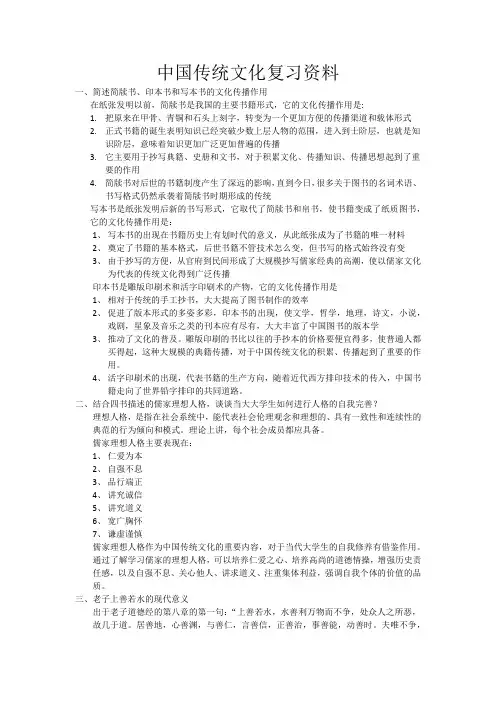
中国传统文化复习资料一、简述简牍书、印本书和写本书的文化传播作用在纸张发明以前,简牍书是我国的主要书籍形式,它的文化传播作用是:1.把原来在甲骨、青铜和石头上刻字,转变为一个更加方便的传播渠道和载体形式2.正式书籍的诞生表明知识已经突破少数上层人物的范围,进入到士阶层,也就是知识阶层,意味着知识更加广泛更加普遍的传播3.它主要用于抄写典籍、史册和文书,对于积累文化、传播知识、传播思想起到了重要的作用4.简牍书对后世的书籍制度产生了深远的影响,直到今日,很多关于图书的名词术语、书写格式仍然承袭着简牍书时期形成的传统写本书是纸张发明后新的书写形式,它取代了简牍书和帛书,使书籍变成了纸质图书,它的文化传播作用是:1、写本书的出现在书籍历史上有划时代的意义,从此纸张成为了书籍的唯一材料2、奠定了书籍的基本格式,后世书籍不管技术怎么变,但书写的格式始终没有变3、由于抄写的方便,从官府到民间形成了大规模抄写儒家经典的高潮,使以儒家文化为代表的传统文化得到广泛传播印本书是雕版印刷术和活字印刷术的产物,它的文化传播作用是1、相对于传统的手工抄书,大大提高了图书制作的效率2、促进了版本形式的多姿多彩,印本书的出现,使文学,哲学,地理,诗文,小说,戏剧,星象及音乐之类的刊本应有尽有,大大丰富了中国图书的版本学3、推动了文化的普及。
雕版印刷的书比以往的手抄本的价格要便宜得多,使普通人都买得起,这种大规模的典籍传播,对于中国传统文化的积累、传播起到了重要的作用。
4、活字印刷术的出现,代表书籍的生产方向,随着近代西方排印技术的传入,中国书籍走向了世界铅字排印的共同道路。
二、结合四书描述的儒家理想人格,谈谈当大大学生如何进行人格的自我完善?理想人格,是指在社会系统中,能代表社会伦理观念和理想的、具有一致性和连续性的典范的行为倾向和模式。
理论上讲,每个社会成员都应具备。
儒家理想人格主要表现在:1、仁爱为本2、自强不息3、品行端正4、讲究诚信5、讲究道义6、宽广胸怀7、谦虚谨慎儒家理想人格作为中国传统文化的重要内容,对于当代大学生的自我修养有借鉴作用。
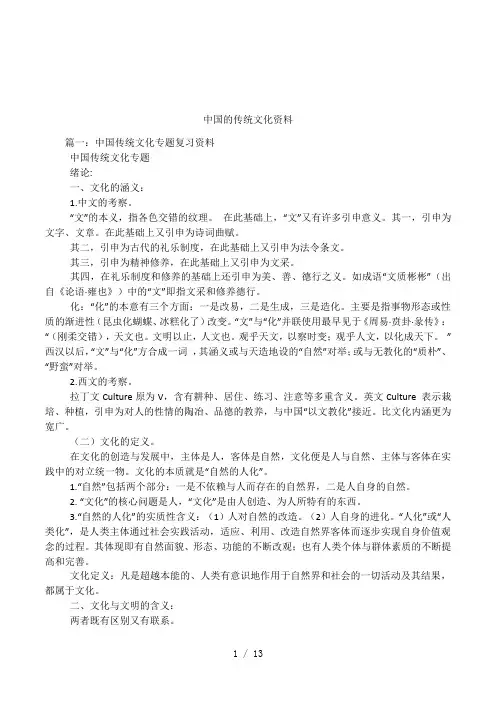
中国的传统文化资料 篇一:中国传统文化专题复习资料 中国传统文化专题 绪论: 一、文化的涵义: 1.中文的考察。
“文”的本义,指各色交错的纹理。
在此基础上,“文”又有许多引申意义。
其一,引申为 文字、文章。
在此基础上又引申为诗词曲赋。
其二,引申为古代的礼乐制度,在此基础上又引申为法令条文。
其三,引申为精神修养,在此基础上又引申为文采。
其四,在礼乐制度和修养的基础上还引申为美、善、德行之义。
如成语 “文质彬彬”(出 自《论语· 雍也》)中的“文”即指文采和修养德行。
化:“化”的本意有三个方面:一是改易,二是生成,三是造化。
主要是指事物形态或性 质的渐进性 (昆虫化蝴蝶、 冰糕化了) 改变。
“文”与“化”并联使用最早见于 《周易· 贲卦· 彖传》 : “(刚柔交错),天文也。
文明以止,人文也。
观乎天文,以察时变;观乎人文,以化成天下。
” 西汉以后, “文”与“化”方合成一词 , 其涵义或与天造地设的“自然”对举; 或与无教化的“质朴”、 “野蛮”对举。
2.西文的考察。
拉丁文 Culture 原为 V,含有耕种、居住、练习、注意等多重含义。
英文 Culture 表示栽 培、种植,引申为对人的性情的陶冶、品德的教养,与中国“以文教化”接近。
比文化内涵更为 宽广。
(二)文化的定义。
在文化的创造与发展中,主体是人,客体是自然,文化便是人与自然、主体与客体在实 践中的对立统一物。
文化的本质就是“自然的人化”。
1.“自然”包括两个部分:一是不依赖与人而存在的自然界,二是人自身的自然。
2. “文化”的核心问题是人,“文化”是由人创造、为人所特有的东西。
3.“自然的人化”的实质性含义: (1)人对自然的改造。
(2)人自身的进化。
“人化”或“人 类化”,是人类主体通过社会实践活动,适应、利用、改造自然界客体而逐步实现自身价值观 念的过程。
其体现即有自然面貌、形态、功能的不断改观;也有人类个体与群体素质的不断提 高和完善。
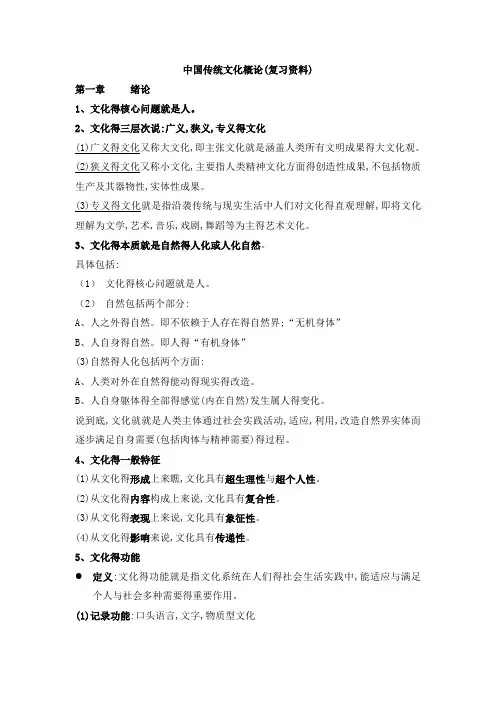
中国传统文化概论(复习资料)第一章绪论1、文化得核心问题就是人。
2、文化得三层次说:广义,狭义,专义得文化(1)广义得文化又称大文化,即主张文化就是涵盖人类所有文明成果得大文化观。
(2)狭义得文化又称小文化,主要指人类精神文化方面得创造性成果,不包括物质生产及其器物性,实体性成果。
(3)专义得文化就是指沿袭传统与现实生活中人们对文化得直观理解,即将文化理解为文学,艺术,音乐,戏剧,舞蹈等为主得艺术文化。
3、文化得本质就是自然得人化或人化自然。
具体包括:(1)文化得核心问题就是人。
(2)自然包括两个部分:A、人之外得自然。
即不依赖于人存在得自然界;“无机身体”B、人自身得自然。
即人得“有机身体”(3)自然得人化包括两个方面:A、人类对外在自然得能动得现实得改造。
B、人自身躯体得全部得感觉(内在自然)发生属人得变化。
说到底,文化就就是人类主体通过社会实践活动,适应,利用,改造自然界实体而逐步满足自身需要(包括肉体与精神需要)得过程。
4、文化得一般特征(1)从文化得形成上来瞧,文化具有超生理性与超个人性。
(2)从文化得内容构成上来说,文化具有复合性。
(3)从文化得表现上来说,文化具有象征性。
(4)从文化得影响来说,文化具有传递性。
5、文化得功能定义:文化得功能就是指文化系统在人们得社会生活实践中,能适应与满足个人与社会多种需要得重要作用。
(1)记录功能:口头语言,文字,物质型文化(2)认知功能:人类总就是不断地通过文化来认识自然,社会,自身,世界。
(3)传播功能:言语与文字,实物(4)教化功能:文化不仅自觉地教化人,而且更多时候就是潜移默化得教化人,使之社会化。
(5)凝聚功能:在民族群体中表现得尤为明显。
中华民族文化得凝聚功能主要表现为爱国主义;文化层次不同,文化凝聚范围,程度,层次也不同。
(6)调控功能:主要依靠精神型文化与制度行为文化来实现。
6、文化形态学角度将广义文化分为四个层次:(1)物态文化;就是指人得物质生产活动方式与产品得总与(2)制度文化;就是人类在社会实践中建立起来得各种社会规范得总与。
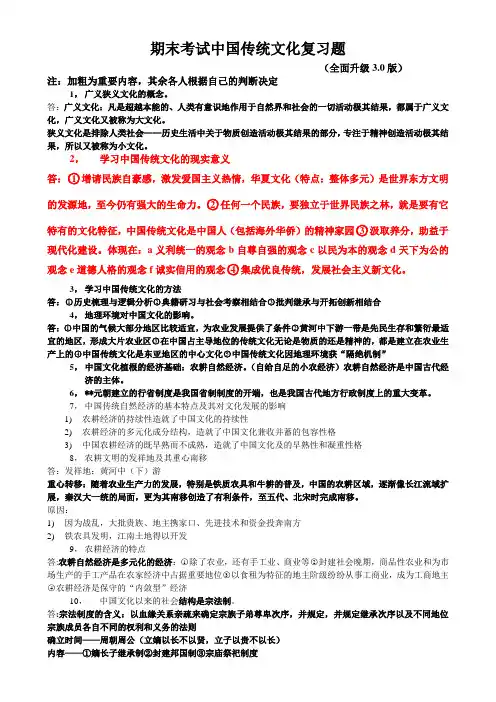
期末考试中国传统文化复习题(全面升级3.0版)注:加粗为重要内容,其余各人根据自己的判断决定1,广义狭义文化的概念。
答:广义文化:凡是超越本能的、人类有意识地作用于自然界和社会的一切活动极其结果,都属于广义文化,广义文化又被称为大文化。
狭义文化是排除人类社会——历史生活中关于物质创造活动极其结果的部分,专注于精神创造活动极其结果,所以又被称为小文化。
2,学习中国传统文化的现实意义答:○1增请民族自豪感,激发爱国主义热情,华夏文化(特点:整体多元)是世界东方文明的发源地,至今仍有强大的生命力。
○2任何一个民族,要独立于世界民族之林,就是要有它特有的文化特征,中国传统文化是中国人(包括海外华侨)的精神家园○3汲取养分,助益于现代化建设。
体现在:a义利统一的观念b自尊自强的观念c以民为本的观念d天下为公的观念e道德人格的观念f诚实信用的观念○4集成优良传统,发展社会主义新文化。
3,学习中国传统文化的方法答:○1历史梳理与逻辑分析○2典籍研习与社会考察相结合○3批判继承与开拓创新相结合4,地理环境对中国文化的影响。
答:○1中国的气候大部分地区比较适宜,为农业发展提供了条件○2黄河中下游一带是先民生存和繁衍最适宜的地区,形成大片农业区○3在中国占主导地位的传统文化无论是物质的还是精神的,都是建立在农业生产上的○4中国传统文化是东亚地区的中心文化○5中国传统文化因地理环境获“隔绝机制”5,中国文化植根的经济基础:农耕自然经济。
(自给自足的小农经济)农耕自然经济是中国古代经济的主体。
6,**元朝建立的行省制度是我国省制制度的开端,也是我国古代地方行政制度上的重大变革。
7,中国传统自然经济的基本特点及其对文化发展的影响1)农耕经济的持续性造就了中国文化的持续性2)农耕经济的多元化成分结构,造就了中国文化兼收并蓄的包容性格3)中国农耕经济的既早熟而不成熟,造就了中国文化及的早熟性和凝重性格8,农耕文明的发祥地及其重心南移答:发祥地:黄河中(下)游重心转移:随着农业生产力的发展,特别是铁质农具和牛耕的普及,中国的农耕区域,逐渐像长江流域扩展,秦汉大一统的局面,更为其南移创造了有利条件,至五代、北宋时完成南移。
中国文化概论复习资料1、文义文化应把握的三种要点?答:(1)文化是与人类及人类的创造活动相联系的是以人类为中心的概念(2)广义文化是一个历史概念它涵盖人类的历史的全过程式是一个传达室承发展的综合概念。
(3)广义文化的外延涵盖是物质创造和精神创造的全部。
考试大收集2、狭隘文化应握的三个要点?答:(1)狭义文化不但发为为中心以人的精神活动为中心即使观农场物化世界也是以其中的人文精神为内枋的(2)狭义文化关注的不是个加紧人的精神活动而是经因史传承累积凝聚的共有的,成体系的人文精神(3)狭义文化关注的不公是全人类的普遍的共性而且更注重不同民族阶层集团文化事象对人类社会存在和发展所起的作用称作文化事象的功能。
3、中国文化形成的统一文化的原因?答:主要基于以下三个原因第一它有着共同的文化源,第二多地了的各民族文化在历史发展的过程中相互交流互相渗透互丰促进形成了多元一体的格局第三汉民族文化在整流器个中华文化中起死回生放导作作,是中华文化的主体文化它在共同估文化的形成和发展中起到了团结和凝聚务民族文化的作用。
4、为什么说文化是一个历史的概念?答:(1)首先,一切文化事象部在一定的历史背景下存在变民发展,从而具有某一时代拭目以待特色(2)其次文化是在历史传承的过程式中积演并确立了自身的传统。
(3)因此我们描写各民族和国家的文化发展历程式,只有在各阶文化纵比较的基础上探求文化发展的总体脉络,总结合文化发民兵的规律,才能对民族和国别文化有清醒的认识。
5、文化传统的物点和作用?答:(1)文化传统是贯穿于民族和国家各个历史阶段的务类文化的核心精神,这种核心精神也是上层文化和底层文化所共有的(2)文化传统具有一定的稳定性和延续性(3)文化传统即有对社会发展的专心致志积极作用的也有对社会起负面作用的。
6、简述中国地理的整体性?答:(1)首先是从多的河流如血脉一样将大主席大的专区连系在一起(2)其次是地理通道虽然地形多样,山岭众多,但不论多么险峻的地势均力敌,大自然总会留给人们以交通的便利。
中国文件概论一、名词解释题1、民族文化:答:民族文化是某一民族在长期共同生产生活实践中产生和创造出来的能够体现本民族特点的物质和精神财富总和。
民族文化反映该民族历史发展的水平。
2、宗法制:答:宗法制度是由氏族社会父系家长制演变而来的,是王族贵族按血缘关系分配国家权力,以便建立世袭统治的一种制度。
其特点是宗族组织和国家组织合二为一,宗法等级和政治等级完全一致。
3、文化:答:指人类在社会历史发展过程中所创造的物质财富和精神财富的总和文化:4、传统文化:答:传统文化就是文明演化而汇集成的一种反映民族特质和风貌的民族文化,是民族历史上各种思想文化、观念形态的总体表征。
二、简答题1、简述中国文化概论开设的目的和任务是什么?答:(1)使学习者树立正确的文化观,增长热爱并继承祖国优秀文化遗产,促进文化发展的意识;(2)使学习者正确认识中华名族的传统文化,把握中国国情,增强爱国主义意识;(3)使学习者对中国文化各分科的具体知识有初步的了解,从而御用这些知识来观察社会,认识社会。
(4)使学习者在提高认识的基础上,加强自身的文化修养,为建设我国社会主义文化做出积极的努力。
2、简述中国传统饮食文化观念表现在哪些方面?答:(一)“以脏补脏”说唐代医学家兼养生学家孙思邈在长期实践中,创立了“以脏补脏”和“以脏治脏”的理论。
例如,肾主骨,他就利用羊骨粥来治疗肾虚怕冷。
肝开窍明目,他又发明了以羊肝来治疗夜盲雀目,这些方法都大大增强了中国饮食中菜肴的科学性。
发展到现在,“以脏补脏”理论和现代饮食技术的结合面越来越广,越来越深入,已成为菜肴创新的一条重要途径。
(二)“发物”忌口说这一学说为中国饮食中“用料广泛”这一特点提供了科学的指导,使其在选料中做到了“博中有精、宽中有窄”,体现了较强的科学辨证性。
所谓“发物”,是指动风生痰、发毒助火助邪之晶,其容易诱发旧病,加重新病。
常见的有鹅肉、鹅蛋、猪头肉、鲤鱼、杏子、李子以及葱蒜之类辛辣刺激性的调味品等。
文化学复习资料文化学复习资料文化学是一门研究人类文化现象的学科,它涉及到人类的价值观、信仰体系、艺术创作、社会组织等方方面面。
在这个信息爆炸的时代,我们对文化学的理解和认识也在不断深化。
本文将为大家提供一些文化学的复习资料,帮助大家更好地掌握这门学科的核心概念和理论。
一、文化的定义和特征文化是指人类在社会生活中创造的一切物质和非物质的精神财富。
它包括了价值观念、道德规范、宗教信仰、艺术创作、科学知识等方面。
文化是人类社会的精神基础,也是人类与其他动物的重要区别之一。
文化具有以下几个特征:1. 文化具有传承性。
文化是代代相传的,通过教育和社会化的方式,人们将文化的知识、价值观念传递给后代。
2. 文化具有创造性。
文化是人类创造的,它反映了人类的智慧和创造力。
通过文化的创造,人类可以改变自然环境,满足自身的需求。
3. 文化具有多样性。
不同地区、不同民族、不同社会群体都有自己独特的文化。
文化的多样性是人类社会的一种丰富性和特色。
4. 文化具有动态性。
文化是不断发展变化的,它随着时间的推移而不断演变。
新的科技、新的思想、新的价值观念都会对文化产生影响。
二、文化的功能和作用文化在人类社会中发挥着重要的功能和作用。
它对个体和社会都有着深远的影响。
1. 个体层面:文化对个体的发展和成长起着重要的作用。
通过文化的教育和熏陶,个体可以获得知识、技能和道德规范,培养自己的思维能力和创造力。
文化还可以帮助个体建立自我认同和归属感,提高个体的社会适应能力。
2. 社会层面:文化对社会的稳定和发展起着重要的作用。
文化可以凝聚社会共识,形成社会的认同和凝聚力。
它还可以传递社会价值观念和道德规范,引导社会行为的规范化和规范化。
文化还可以推动社会的创新和进步,促进社会的发展和繁荣。
三、文化的传播和交流文化的传播和交流是文化学研究的重要内容之一。
在全球化的背景下,文化的传播和交流变得更加频繁和广泛。
1. 传统的文化传播方式:传统的文化传播方式主要包括口头传统、书面传统和艺术传统。
文化学原理-复习资料第一章概述二、文化的几种定义1、现象描述性定义。
“人类学之父”泰勒对文化的定义是:“文化,或文明,就其广泛的民族学意义来说,是包括全部的知识、信仰、艺术、道德、法律、风俗以及作为社会成员的人所掌握和接受的任何其他的才能和习惯的复合体。
”2、社会反推性定义3、价值认定性定义4、结构分析性定义5、行为取义性定义6、历史探源性定义7、主体立意性定义三、文化界定1、泰勒在1871年发表《原始文化》这一里程碑式的著作并给文化第一次下了定义2、所谓文化,就是人类在存在过程中为了维护人类有序的生存和持续的发展所创造出来的关于人与自然、人与社会、人与人之间各种关系的有形无形的成果。
3、原因/特点:①群体共享②客观显性、主观隐形③客观显性、主观隐形二者同时产生影响④代代相传,变化速度慢第二节文化学的研究对象、范围和目的一、文化学的研究对象文化学是一门关于研究探讨文化的产生,创造,发展,演变规律和文化本质特征的科学。
(一)文化学不同于自然科学文化学的研究对象是人类创造的文化现象而不是自然现象(二)文化学不同于一般的或具体的各门社会科学文化学以一切文化现象、文化行为、文化本质、文化体系、文化类型(模式)以及文化产生和发展演变规律为自己研究对象,并对其进行综合性的研究,以揭示文化现象的本质和内在规律。
(三)文化学不同于哲学哲学的研究偏重于人类的认识规律,而文化学的研究则偏重于人类文化的创造活动与成果以及它们之间存在的关系文化学的研究对象还包括不同的构成方面和层次。
从构成上来看,文化学的研究对象有纵向的历史文化、现实文化,也有横向的不同区域,国家或民族的文化;从层次上来看,文化学的研究对象有理论文化和实践文化。
二、文化学的研究范围1、文化学或文化科学的称谓最早出现于德国2、德国学者列维?皮格亨首次提出了“文化科学”这一术语,主张进行文化研究,建立专门的学科3、《原始文化》被认为是近代科学意义上第一部研究人类文化的学术专著,泰勒本人也被尊为文化学的奠基人。
文化学概论期末复习资料一、名词解释1.文化:人类在存在过程中为了维护人类有序的生存和持续的发展所创造出来的关于人与自然、人与社会、人与人之间各种关系的有形无形的成果。
2.文化累积:人类文化发展的基本形式,是指人类特有的创造文化、保存文化并在此基础上再创造文化,使文化不断增长和丰富的能力。
3.文化创新:由连续的文化积累和对外来文化的借鉴吸收而导致的一种文化创造。
4.文化发明:人们在社会实践中,在原有文化的基础上,为了满足和发展自身的需要,创造出新的物质文化产品或新的精神文化产品以及相应地创造出新的活动方式,包括行为方式和思维方式等。
5.文化圈:是一个文化空间概念,即具有一定数量、具有相同文化元素的地域范围。
6.文化层:指在文化发展的历史进程中,存在着不同的层次,每一层次都反映着不同时期的不同文化特征。
7.文化区:又称文化区域,主要指具有相似文化特征和生存方式的区域分类或空间分布。
8.文化模式:一种文化形成的一贯的、稳定的特征和经验,既有心理与价值的层面,同时也有行为和制度的层面,在其他文化结构和文化功能上均有着特定的规范。
9.涵化:两个或两个以上的文化群体由于持续接触,造成一方或双方都发生了大规模的变迁。
有强制涵化和非强制涵化两种。
10.文化冲突:两个或两个以上的文化群体由于文化模式中存在较大的差异,产生了文化认同上的障碍,继而导致文化间的交锋、紧张与对抗。
一般来讲,文化冲突最终会走向文化的融合、同化或是分化。
二、填空概念1.文化学的研究范围主要体现在物质文化、行为文化、制度文化和精神文化等。
2.“文化决定论”——一切文化都是由其原型文化所决定的,人类的创造性行为受文化系统的制约。
文化是一种构架,包括内隐的和外显的行为模式,文化的核心是价值观念。
3.传播学派:物质文化或习惯行为是从一起源社会散播到其他社会的。
竭力反对古典进化论的“独立发明说”和“平行发展说”,成为学术观点上古典进化论的第一个对立学派。
中国文化概论总复习资料一. 名词解释。
1. 文化:广义是指人类在长期的历史发展中共同创造并赖以生存的物质与精神存在的总和。
狭义的文化专指人类的精神创造,它着重人的心态部分。
2. 文化事象:当一种现象以同样的形式反复出现,其中就含有规律性,成为某一历史时期、某一国家(民族或地域)文化发展中带有典型和标志作用的事情,这些现象就称为文化事象。
3. 传统文化:是对文化的传承而言的,它强调的是文化的本源和沿着这个本源传承下来的全部文化遗产。
4. 文化传统:是贯穿于民族和国家各个历史阶段的各类文化的核心精神。
5. 方志时期:竺可桢将从公元1400 年到1900 年划为第三个气候时期,为寒冷时期,因为这一时期明清现代我国多数地方都有了方志,对区域性的气候变化做了更为详细的记录,故而得名。
6. 分封制:西周建立后,把大批同姓贵族和异姓亲信赐封到各地建立诸侯国家,史称封建,所形成的社会制度,就是分封制。
7. 永嘉之乱:永嘉五年(311 年),匈奴贵族刘渊的军队攻陷洛阳,俘虏晋朝皇帝,西晋灭亡,史称“永嘉之乱” 。
8. 一条鞭法:是明朝张居正主持的旨在增加国库收入、减轻民众负担的税制改革,内容是把田赋、力役及其他名目繁多的杂税合成一条,统一按田亩数量征收,同时还简化了征收手续。
9. 儒户:是元朝根据宗教派别划分出的户籍,与佛教、道教、穆斯林、景教、阴阳先生、萨满教巫师户同等级。
10.中国的生产经济文化:指在中国传统的农耕自然经济的基础上,所产生、发展和连续传承的一种社会文化形态,又称农业文明。
11.家庭:指共同居住、经济协助、有血缘关系的社会集团。
12.家族:是由出生和婚姻形成的亲属关系,里面包括血缘关系和姻缘关系。
13.赌胜:实质是打赌,碰运气,刺激人们从感官上接近神、共享神佑的愿望。
如触摸某寺庙山门前的某一动物形状或形态殊异的一小块建筑物,表示能得到一种定向的神赐。
14.宗法制:是中国古代维护贵族世袭统治的一种制度,由父系家长制演变而成,到周代渐趋完备。
国际商务文化复习资料<是非判断题一>答题说明:请阅读以下表述并判断表述是否正确,若表述正确,请在正确的表述前括号中标示T;若表述错误,请在正确的表述前括号中标示F。
1.( ) The terms of intercultural communication and international communicationcan be used interchangeably.2.( ) Stereotypes, like culture itself, are learned in a variety of ways. They are theproducts of limited, lazy and misguided perceptions.3.( ) Verbal communication is not as clarified and efficient as other ways ofcommunication, e.g. written communication.4.( ) We put the index finger and mid-figure apart with palm against the receiverto mean “OK,” which was first used by Winston Churchill.5.( ) Personal territory can be large or small, which is much related to certainelements such as place, sex, age and character.6.( ) Where the power distance is large, the society believes that there should be awell-defined order of inequality in which everyone has a rightful place.7.( ) Asian, Latin American, and West African nations are societies high inindividualism but low in collectivism.8.( ) In high masculinity societies, people tend to believe that matters of materialcomfort, social privilege, etc. are related to ability.9.( ) For some multinational firms, they can alleviate culture shock by selectingemployees for overseas assignments who possess certain personal and professional qualifications.10.( ) Nonverbal greetings include shaking hands, kissing, bowing and makingintroductions.<是非判断题二>答题说明:请阅读以下表述并判断表述是否正确,若表述正确,请在正确的表述前括号中标示T;若表述错误,请在正确的表述前括号中标示F。
1.( ) With the integration of language into the fabric of culture, confusion anddysfunction would reign and the culture would fail.2.( ) Language is a means to express and exchange thoughts, concepts,knowledge and information as well as to transmit experience and so on.3.( ) Personal territory can be large or small, which is much related to certainelements such as place, sex, age and character.4.( ) Where uncertainty avoidance is low, the society is comfortable with a lowdegree of certainty and is open to the unknown.5.( ) In high-context communication, the listener is already “contexted”and sodoes not need to be given much background information.6.( ) In U.S., a businessman who is invited for dinner to the private home of abusiness contact is expected to write a thank-you note shortly after the event.7.( ) American negotiators tend to be competitive in their approach to negotiation,beginning with a realistic offer.8.( ) It is not advisable to make a high offer at the beginning of negotiation.9.( ) The effective management principle and method for a local corporationmight not achieve expected result if employees come from different countries in international corporation.10.( ) Nonverbal greetings include shaking hands, kissing, bowing and makingintroductions.<是非判断题三>答题说明:请阅读以下表述并判断表述是否正确,若表述正确,请在正确的表述前括号中标示T;若表述错误,请在正确的表述前括号中标示F。
1.( ) Stereotypes, like culture itself, are learned in a variety of ways. They are theproducts of limited, lazy and misguided perceptions.2.( ) Language and culture are closely related, reflecting, influencing and shapingeach other.3.( ) Eye looking sideways can show one’s coldness and superciliousness. It isimpolite to move your head side to side while you are communicating with people,e.g. in India or Pakistan.4.( ) Postures send same messages to all people, e.g. when you stand in an uprightposition, you impress others as being energetic.5.( ) Individualists prefer self-sufficiency while collectivists give more recognitionto their interdependent roles and obligations to the group.6.( ) Large power distance countries such as the United States, Austria, Finland,and Denmark hold that inequality in society should be minimized.7.( ) German businessmen have serious principles about interpersonal relationshipand they focus on personal credit.8.( ) Control of the schedule often leads to control of the negotiating agenda.9.( ) The goal at a cocktail party is to meet as many people as possible. Everyoneexpects to get into deep discussions.10.( ) Culture offers ways of identifying with the organization and creates a“you-feeling.”<是非判断题四>答题说明:请阅读以下表述并判断表述是否正确,若表述正确,请在正确的表述前括号中标示T;若表述错误,请在正确的表述前括号中标示F。
1.()Culture is all men’s medium; there is no aspect of human life that is nottouched and altered by culture.2.( ) Verbal communication is not as clarified and efficient as other ways ofcommunication, e.g. written communication.3.( ) A simple eye gesture might be interpreted in a diversity of meanings acrosscultures.4.( ) How closely people position themselves to one another during a discussion ortalk cannot communicate what type of relationship exists between them.5.( ) Where individualism id high, the society emphasizes the role of the group.6.( ) In high-context communication the listener is already “contexted”and sodoes to need to be given much background information.7.( ) Some businesspersons maintain that American humor is helpful to export andappreciate.8.( ) Taboos often are rooted in the beliefs of the people of a specific region orculture and are passed down from generation to generation.9.( ) Japanese negotiators tend to put more emphasis on the literal meanings ofwords used in negotiation and less emphasis on the relationships established before negotiating begins.10.( ) Culture serves to create a general consensus on fundamental issues andfacilitates decision-making during crises.答案:<是非判断题一>1. T2. T3. F4. F5. T6. T7. F8. T9. T 10. F<是非判断题二>1. F2. T3. T4. T5. T6. T7. F8. F9. T 10. F<是非判断题三>1. T2. T3. F4. F5. T6. F7. T8. T9. F 10. F<是非判断题四>1. T2. F3. T4. F5. F6. T7. F8. T9. F 10. T<匹配题一>答题说明:请将以下表述与表中的概念对应,并将选项写在表述前的括号中,每个选项只能使用一次。